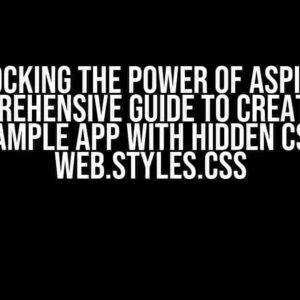Have you ever struggled with creating a responsive web design that adapts seamlessly to different screen sizes? You’re not alone! Many developers, including myself, have faced this issue, and it can be frustrating when your code doesn’t quite work as expected. In this article, I’ll share my personal experience of writing code to change my web responsiveness according to screen size with the help of W3Schools, and provide a step-by-step guide to help you overcome similar challenges.
The Goal: Achieving Responsive Web Design
Responsive web design is an essential aspect of modern web development. It ensures that your website looks and functions beautifully on various devices, including desktops, laptops, tablets, and mobile phones. The primary goal is to create a design that adapts to different screen sizes, resolutions, and orientations, providing an optimal user experience.
The Problem: Unresponsive Design
When I wrote a code to change my web responsiveness, I expected it to work seamlessly across different screen sizes. But, to my dismay, it didn’t quite work as expected. The layout was broken, and the design looked distorted on certain devices. I was left wondering what went wrong and how to fix it.
Understanding the Basics of Responsive Web Design
Before diving into the solution, let’s cover the basics of responsive web design. It’s essential to understand the following concepts:
- Media Queries: These are conditional statements that define different styles for various screen sizes and devices.
- Breakpoints: These are specific points at which your design changes or adapts to different screen sizes.
- Mobile-First Design: This approach involves designing for small screens first and then working your way up to larger screens.
- Responsive Units: These include relative units like percentages, em, and rem, which help create a flexible design.
Writing Code to Change Web Responsiveness
Now, let’s get into the nitty-gritty of writing code to change web responsiveness. I’ll share my original code and explain what went wrong. Then, I’ll provide a corrected version and guide you through the process.
<style>
/* original code */
@media only screen and (max-width: 768px) {
.container {
width: 90%;
margin: 0 auto;
}
}
@media only screen and (max-width: 480px) {
.container {
width: 80%;
margin: 0 auto;
}
}
</style>
The original code was supposed to change the container’s width based on the screen size. However, it didn’t quite work as expected. The design looked broken, and the layout was distorted.
What Went Wrong?
After analyzing the code, I realized that the issue was due to the following reasons:
- The media queries were not specific enough, causing the design to break on certain devices.
- The breakpoints were not defined correctly, leading to inconsistencies in the design.
The Solution: Corrected Code and Best Practices
Let’s rewrite the code, incorporating best practices and W3Schools’ guidelines. We’ll create a responsive design that adapts to different screen sizes.
<style>
/* corrected code */
@media only screen and (max-width: 1200px) {
/* Large desktop */
.container {
width: 90%;
margin: 0 auto;
}
}
@media only screen and (max-width: 992px) {
/* Medium desktop */
.container {
width: 85%;
margin: 0 auto;
}
}
@media only screen and (max-width: 768px) {
/* Tablet */
.container {
width: 80%;
margin: 0 auto;
}
}
@media only screen and (max-width: 480px) {
/* Mobile */
.container {
width: 90%;
margin: 0 auto;
}
}
</style>
In the corrected code, we’ve:
- Defined more specific media queries with clear breakpoints.
- Used relative units (percentages) for the container’s width.
- Added margin: 0 auto to center the container.
Additional Tips for Achieving Responsive Web Design
In addition to the corrected code, here are some additional tips to ensure your web design is responsive:
- Use a mobile-first approach: Design for small screens first and then work your way up to larger screens.
- Define clear breakpoints: Identify specific points at which your design changes or adapts to different screen sizes.
- Use responsive units: Incorporate relative units like percentages, em, and rem to create a flexible design.
- Test and iterate: Test your design on various devices and iterate upon it to ensure it looks and functions as expected.
- Use W3Schools’ resources: Utilize W3Schools’ extensive collection of tutorials, examples, and reference materials to master responsive web design.
Conclusion
Creating a responsive web design that adapts to different screen sizes can be a challenging task, but with the right approach and knowledge, it’s achievable. By understanding the basics of responsive web design, writing code that adapts to different screen sizes, and following best practices, you can ensure your website looks and functions beautifully on any device. Remember to test and iterate upon your design, and don’t hesitate to seek help from resources like W3Schools. Happy coding!
| Screen Size | Breakpoint | Description |
|---|---|---|
| 1200px and above | Large desktop | Full-width design with ample spacing |
| 992px – 1199px | Medium desktop | Slightly narrower design with adjusted spacing |
| 768px – 991px | Tablet | Compact design with reduced spacing |
| 480px and below | Mobile | Single-column design with minimal spacing |
This table provides a general guideline for defining breakpoints and adapting your design to different screen sizes. Remember to adjust the values based on your specific design requirements.
I hope this comprehensive guide has helped you overcome the challenges of creating a responsive web design that adapts to different screen sizes. With W3Schools’ resources and these best practices, you’re well on your way to crafting a stunning and responsive website.
Frequently Asked Question
Stuck with unresponsive web design? Worry not! We’ve got the answers to get you back on track.
Q1: Have I correctly implemented the media queries?
Double-check your code for correct syntax and placement of media queries. Ensure you’ve defined the screen sizes correctly, and the order of the media queries is from smallest to largest. Also, verify that you’ve added the necessary units (e.g., px, em, or %) to the values.
Q2: Are my CSS selectors targeting the correct elements?
Inspect your HTML elements using the browser’s developer tools to ensure your CSS selectors are targeting the correct elements. Verify that you’ve used the correct class or ID names, and that they match the ones defined in your HTML structure.
Q3: Have I overridden any default CSS styles?
Check if you’ve accidentally overridden any default CSS styles or properties. Sometimes, a simple CSS property can override your media query styles. Use the browser’s developer tools to inspect the element’s styles and verify that your media query styles are being applied correctly.
Q4: Are there any CSS framework or library conflicts?
If you’re using a CSS framework or library, it might be overriding your custom styles. Check the documentation of the framework or library to see if there are any built-in responsive design features that might be conflicting with your custom media queries.
Q5: Have I tested my code in different browsers and devices?
Test your code in different browsers, devices, and screen sizes to ensure your media queries are working as expected. This will help you identify any browser-specific issues or inconsistencies in your responsive design.


